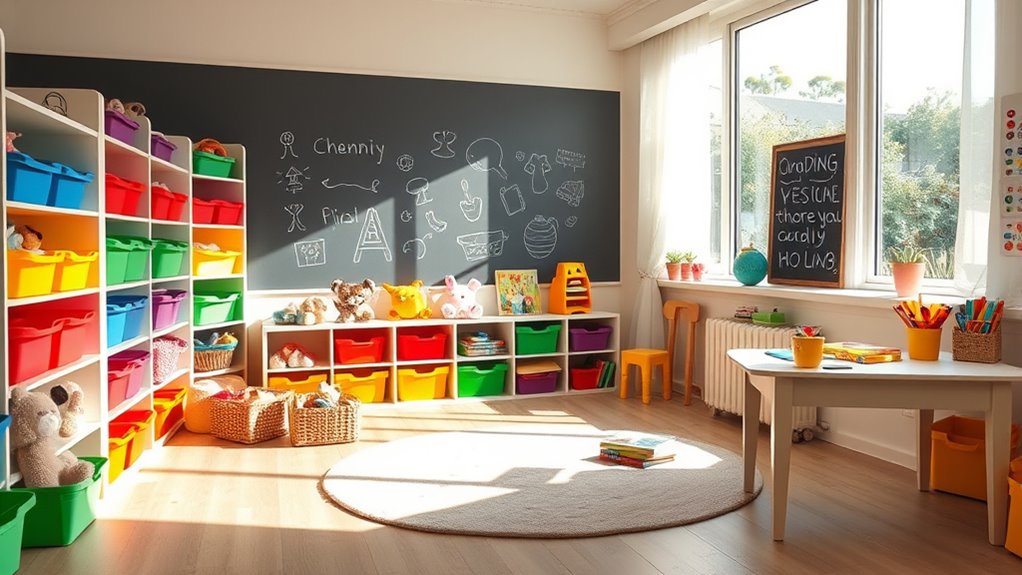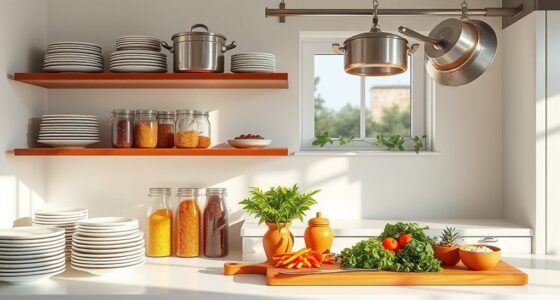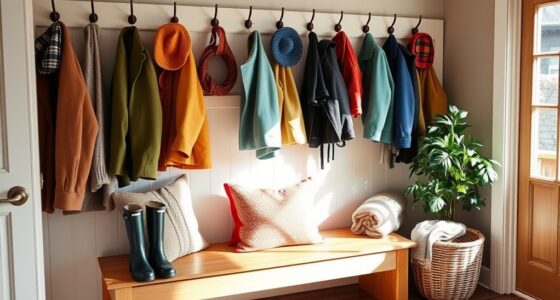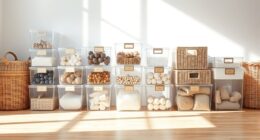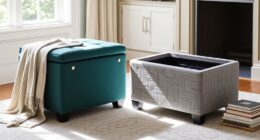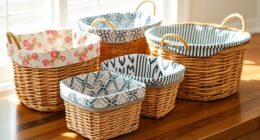To organize your playroom without a fight, start by involving your kids in the process. Set clear expectations for which toys to keep or donate, making it a fun activity. Create distinct zones for different activities and use labeled bins for easy access. Prioritize safety by securing furniture and removing sharp edges. Establish a daily cleanup routine that's engaging, and celebrate their contributions. With these strategies in place, you'll find even more helpful tips to keep things running smoothly.
Key Takeaways
- Involve children in the organizing process by letting them choose which toys to keep or donate, fostering ownership and responsibility.
- Create distinct activity zones with labeled storage to help children know where items belong, making cleanup straightforward.
- Turn cleanup into a fun game by setting a timer or using music, encouraging children to participate without resistance.
- Establish a daily cleanup routine, making it a habit and reinforcing positive behavior through praise and celebration of their efforts.
- Implement a "one in, one out" policy to prevent clutter buildup and maintain a tidy playroom, teaching children about managing their belongings.
Assessing the Room's Layout
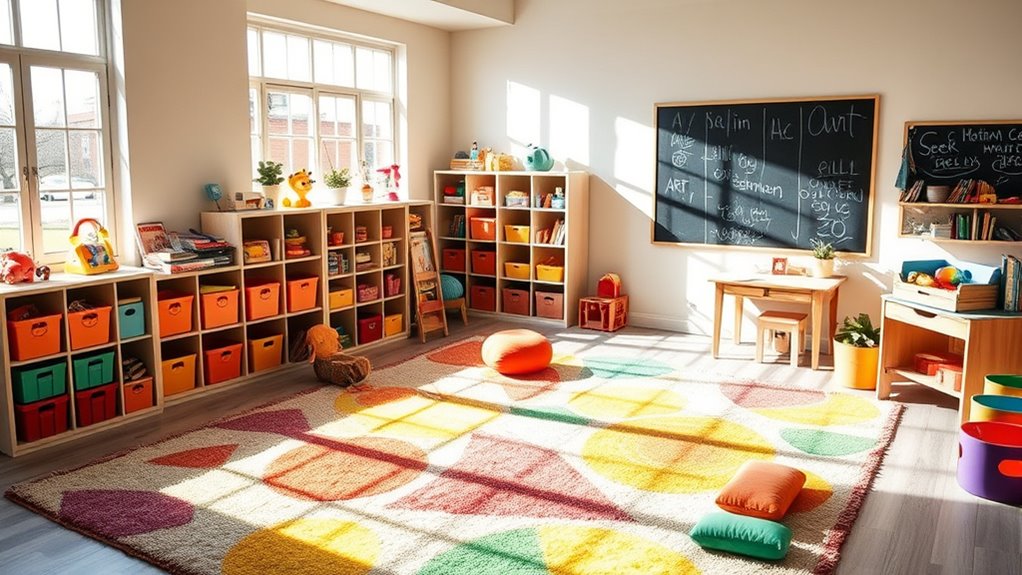
When you start organizing your playroom, assessing the room's layout is essential to creating a functional space.
First, measure the room's dimensions to determine where furniture and play areas will fit best. Consider how much natural light enters the room; this can influence your lighting choices. Ensure adequate natural light or plan for additional lighting solutions to enhance the play environment.
Ensure the space is easily accessible for both kids and adults, promoting a safe environment. Plan your furniture placement carefully to maximize both space and functionality.
Designate specific play zones, like areas for reading, arts and crafts, or active play. By identifying these key areas, you'll create a well-organized and engaging playroom that caters to your child's needs and interests.
Setting a Budget for Organization

Creating a budget for organizing your playroom is crucial to ensure you meet your needs without overspending. Start by prioritizing essential items that promote long-term use, considering your children's ages and interests. Allocate funds for effective storage solutions and explore budget-friendly alternatives like second-hand items or DIY projects. Whole foods can be a great inspiration for eco-friendly storage solutions that are both functional and sustainable. Use items you already have at home, visit thrift stores, and check dollar stores for affordable bins. Keep track of expenses with a spreadsheet and set spending caps for each category. Regularly review and adjust your budget to maintain cost-effectiveness. Implement a toy rotation system and encourage your kids to help keep the space organized. This way, you'll sustain a well-organized playroom without breaking the bank. Additionally, properly categorizing toys will make it easier to maintain organization and ensure everything has a designated place.
Creating Activity Zones

Organizing your playroom into distinct activity zones can transform the space into a more functional and enjoyable environment.
Start by identifying zones like reading, arts and crafts, pretend play, and sensory activities. Each zone serves a specific purpose, fostering learning, creativity, or relaxation. By implementing clear activity zones, you can enhance overall enjoyment of the room through organization. Each zone can also contribute to emotional and psychological growth, enriching your child's development through diverse play experiences.
Create a layout that mentally divides the room, maximizing space and accessibility. Use versatile furniture and fitting storage solutions tailored to each zone's needs.
Label each area clearly, so your children know where things belong. Involve them in the setup and maintenance to encourage ownership.
Lastly, keep zones adaptable to their changing interests, ensuring the playroom remains inviting and engaging for independent play.
The Importance of Decluttering

While a playroom filled with toys can seem inviting, clutter often undermines its potential for fun and learning. When you declutter, your child can focus better, leading to more productive play.
A well-organized space not only fosters creativity but also enhances problem-solving skills and independent play. Clutter can overwhelm kids, hindering their cognitive growth and decision-making skills. Additionally, a well-organized playroom promotes independent play, which is crucial for child growth. Creating an organized space can transform your home into an organized oasis that encourages exploration and discovery.
Moreover, a tidy environment reduces stress and anxiety for both you and your child, creating a sense of calm. Safety is another crucial factor—less clutter means fewer tripping hazards and easier supervision.
Involving your child in the decluttering process teaches responsibility and helps maintain organization, ensuring your playroom remains a joyful and functional space for everyone.
Seasonal Toy Editing
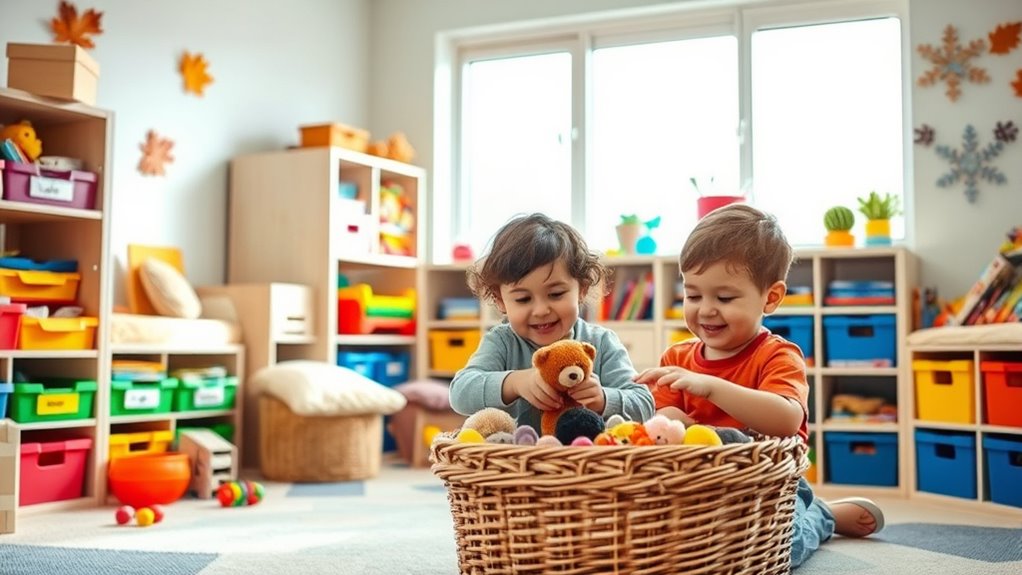
After decluttering your playroom, it's the perfect time to consider seasonal toy editing.
Start by selecting props that reflect the current season, like leaves for autumn or snowflakes for winter. Incorporate seasonal backgrounds, such as a beach scene for summer or a cozy cabin for winter, to enhance your toy photography. Remember to experiment with bokeh technique to create a dreamy effect with fairy lights that complement your seasonal theme.
Select seasonal props and backgrounds to elevate your toy photography and spark creativity.
Use colored lights or gels to match the seasonal mood, and experiment with natural light for stunning effects.
Create narratives around your toys, like a character enjoying a snowy adventure, to engage your child's imagination.
Don't forget to utilize image editing software to add seasonal touches, ensuring your photos capture the essence of each season beautifully and creatively.
Innovative Storage Solutions
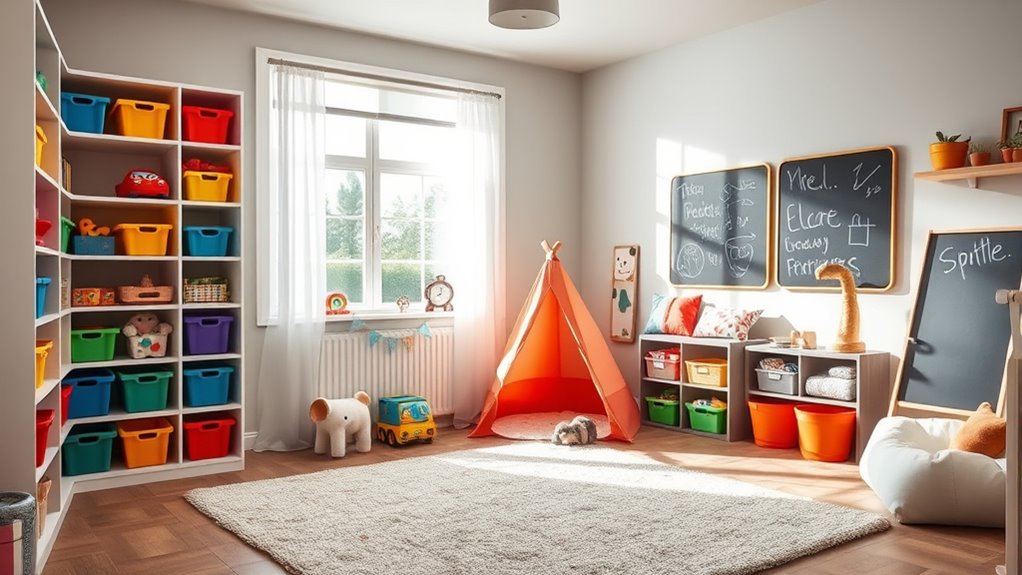
Transforming your playroom into a clutter-free haven can be achieved with innovative storage solutions that maximize space and functionality.
Install wall-mounted shelves to keep books and toys organized and off the floor. Use pegboards for hanging baskets and hooks, creating a customizable storage area. Utilizing vertical space with these solutions can significantly free up floor space, making the room appear larger and less cluttered. Incorporating natural materials like wood in your storage solutions can add warmth and a cozy aesthetic to the playroom.
Consider custom storage cabinets for a sleek look, hiding away board games and puzzles. Incorporate multi-functional furniture like storage ottomans and desks with built-in compartments to make the most of your space.
Designate activity zones—a cozy reading nook, an art station, or a building zone—to keep things organized. Label bins and zones clearly to simplify cleanup.
Regularly declutter to maintain a manageable environment, ensuring your playroom stays inviting and functional.
Encouraging Children to Participate
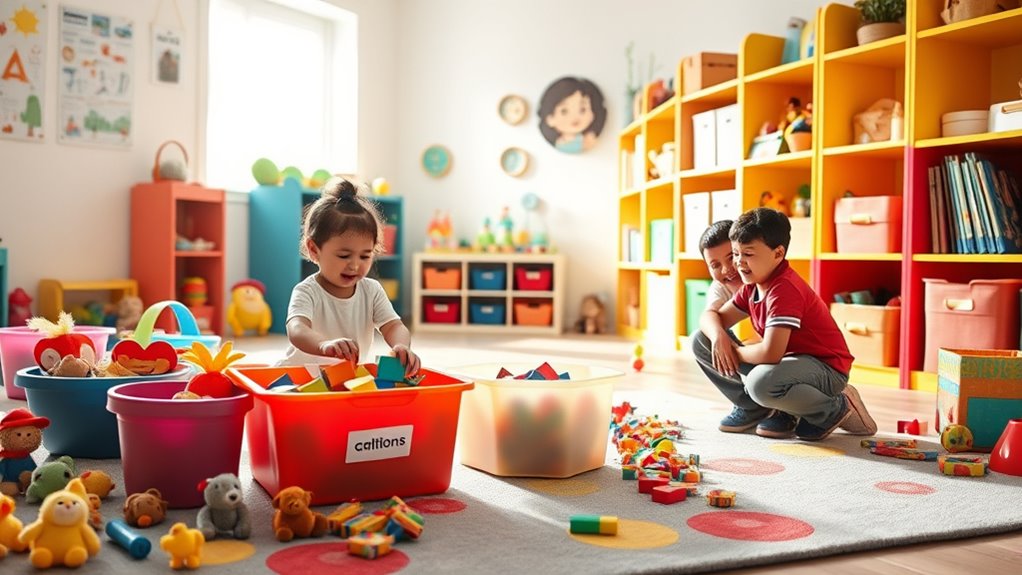
Getting your children involved in organizing their playroom can make the process smoother and more enjoyable. Start by including them in decisions about which toys to keep or donate; this helps them understand the importance of the process. Explain how their donations can help other kids, making it easier for them to let go. Setting clear expectations about the lifespan of toys, and encouraging their input gives them a sense of control. You can boost their ownership by letting them label storage bins and customize their space. Make cleanup fun by turning it into a game or cleaning together as a family. Celebrating their successes can motivate ongoing participation and reinforce their responsibility in maintaining a tidy playroom. Remember that involving children in the purging process can lead to greater appreciation for their remaining toys. Encouraging children to participate in organizing fosters strong communication skills, which are essential for teamwork and collaboration.
Simplifying Cleanup Processes
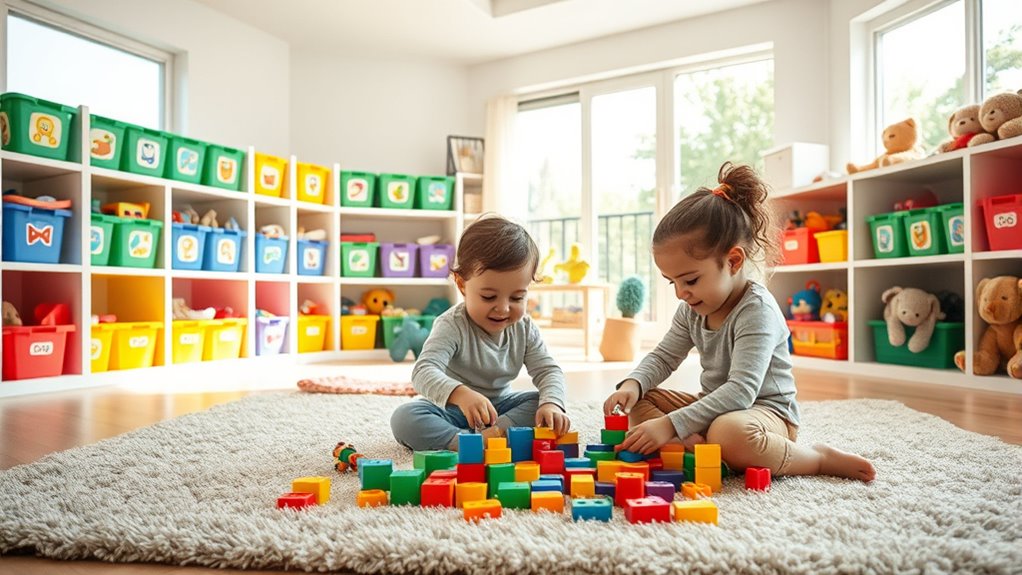
Involving your children in organizing their playroom sets the stage for a smoother cleanup process. Start by decluttering together—remove broken toys and items they no longer use. Sort everything into keep, donate, and discard piles, letting them make decisions. Regularly review their toy collection to maintain space and donate unused items. Organize storage with clear bins for visibility and label them for easy identification. Consider cube storage units and open shelving that kids can reach. Create designated play zones for activities like reading, art, or building, making cleanup manageable. Finally, establish a daily cleanup routine. Make it fun and engaging, and rotate toys to keep play exciting while encouraging habits that foster ongoing organization. Additionally, ensure all supplies are within reach to streamline the cleaning process. Incorporating well-organized storage can significantly improve the efficiency of the cleanup process.
Safety Considerations for Playrooms
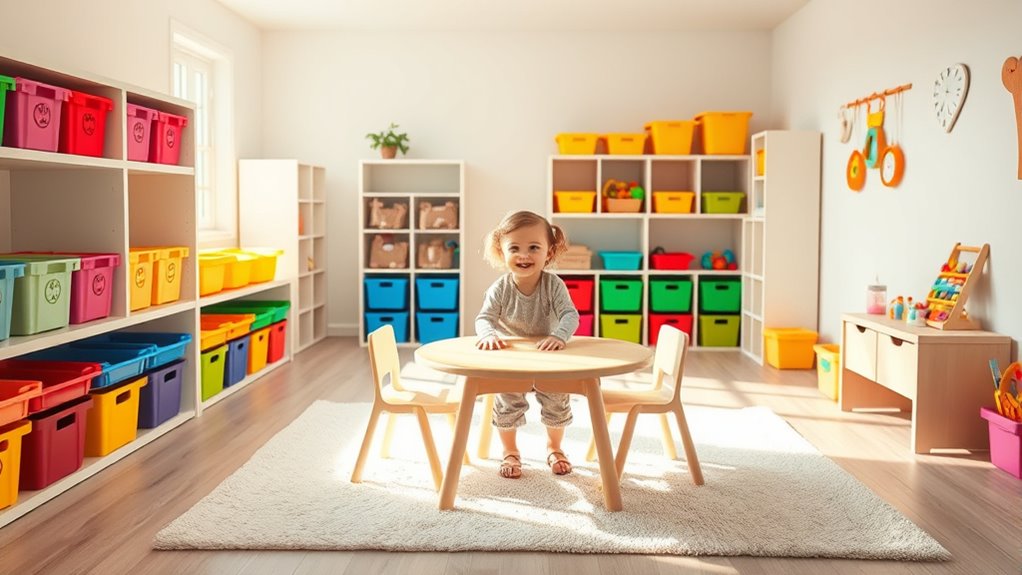
When creating a safe playroom for your children, it's crucial to consider various safety measures that protect them from potential hazards.
Start by securing doors and windows to prevent accidents. Install safety brackets on furniture to avoid tip-overs, and remove sharp edges to minimize injury risks. Additionally, investing in secure locks for all doors leading outside can provide extra peace of mind. Understanding the importance of childproofing techniques is essential for maintaining a safe environment.
Soft, kid-friendly flooring can help cushion falls, while hidden electrical cables will reduce tripping hazards. Design the room for easy supervision, and consider using security cameras for added monitoring.
Regularly check toys for wear, and avoid those with small parts or button batteries. Keeping the space clean and clutter-free to prevent accidents, and having a first aid kit readily accessible for emergencies is vital. Your children's safety should always be a top priority.
Maintaining an Organized Space

To maintain an organized playroom, it's essential to establish a system that works for both you and your children. Regular decluttering is key; aim to declutter toys at least twice a year, involving your kids to teach them about sharing. Implement a "one in, one out" policy to prevent clutter buildup. Create organized zones for different activities, ensuring each zone has adequate storage and is clearly labeled. Use open storage and unlidded bins to make cleanup simple and keep toys visible. Utilizing baskets can help categorize toys and make organization intuitive for your children. Additionally, consider incorporating durable materials that can withstand rough play to maintain the longevity of your storage solutions.
Encourage cleanup habits by establishing routines and making storage accessible. Praise your children for their efforts to maintain the space, and adjust your system as their interests evolve. Consistency is crucial for long-term organization.
Frequently Asked Questions
How Do I Motivate My Kids to Help Organize Their Playroom?
To motivate your kids to help organize their playroom, start by making cleanup fun.
Turn it into a game or play music while they work. Use reachable storage bins so they can easily put things away.
Involve them in deciding where items go to give them ownership. Establish a routine, and praise their efforts to build responsibility.
Celebrate their successes, no matter how small, to keep their enthusiasm alive.
What Are Some Inexpensive DIY Storage Solutions for Toys?
If you're looking for inexpensive DIY storage solutions for toys, consider using cardboard boxes covered in colorful Duct Tape for a fun touch.
Vintage crates can serve as stylish storage bins, while old furniture like dressers can be repurposed into toy organizers.
Also, think about hanging back-of-door organizers or utilizing under-bed storage bins.
Labeling canvas bins and using large baskets will help you keep everything tidy and easily accessible.
How Can I Make Cleaning up a Fun Activity?
Cleaning up can feel like a mountain to climb, but it can also be a thrilling adventure!
Turn cleanup into a game by setting timers for speed challenges or creating scavenger hunts. Use toys like dump trucks to make picking up fun.
Add music to the mix, and encourage your kids to dance as they tidy. By making it enjoyable, you'll inspire them to embrace cleanup and make it a regular habit.
What Toys Should I Prioritize Keeping in the Playroom?
When prioritizing toys for your playroom, focus on versatile items that encourage creativity and development.
Keep open-ended toys like unit blocks and educational puzzles, as they foster problem-solving. Imaginative play toys, such as play silks, can spark creativity.
Don't forget sensory toys for tactile experiences and building sets for spatial skills.
Rotate toys regularly to maintain excitement and involve your kids in choosing what to keep, ensuring a balanced and engaging collection.
How Often Should I Reassess the Playroom Organization?
Imagine you're hosting a playdate and toys are scattered everywhere.
To keep your playroom organized, reassess it regularly—at least every few months. You might schedule a decluttering session each season, making it a fun family activity.
Involve your kids in deciding what to keep and rotate toys to keep things fresh.
Daily tidy-ups can help maintain order, ensuring your playroom remains an inviting space for creativity and play.
Conclusion
So, you've tackled the playroom organization and thought you'd finally have a peaceful space. But guess what? The kids can still turn it into a tornado zone in seconds! Embrace the irony—while you strive for order, their creativity thrives in chaos. Remember, it's not about having a perfectly organized playroom; it's about making it a joyful, messy haven for your little ones. After all, true memories are made in the clutter, not the neatness.
